



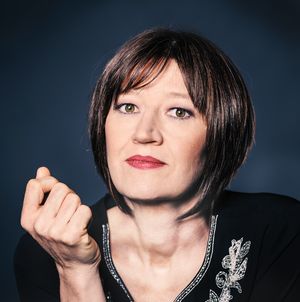 Born in Malmö, Sweden, I grew up in a home of contradictions. Mum gave up her career as a church organist in order to help my dad with his freshly started engineer project and thus became his secretary - how ordinary!
Born in Malmö, Sweden, I grew up in a home of contradictions. Mum gave up her career as a church organist in order to help my dad with his freshly started engineer project and thus became his secretary - how ordinary!
Our home carried imprints of both worlds, the pragmatic creativity of my fathers crazy inventions and the controlled beauty of my mothers tentative piano playing. A contradiction in itself, the world of engineering traditionally being considered one of control and the world of music consequently as its creative opposite.
But my father was the crazy, spontaneous man in my family. One who gave up playing the trumpet in his own big band because he realized he would never be the world's best player. One that revolutionized the paint spray device in the early 70's - at least he said so - and the first one to come up with the idea to transport bulk material with vacuum.
He died in 2012. He never became the world's best trumpet player but managed to invent enough vacuum devices to put him on the unofficial map of great inventors.
Me...I finally took up music after first following my dad's advice for 10 years dancing the engineering waltz - unwillingly I might add - and then I gave up my well-paid manager job in one of Sweden's fastest growing electronic companies to live the poor life of an unknown musician who wasn't even an educated such, but a self-taught one. So you might say I followed through what my parents both didn't - a musical career instead of a conventional engineering ditto. Convention has never been my thing anyway.
During those engineer years I sung in different bands, started my own bands and composed/arranged for choirs as well as singing in them. Fresh out of university, working my first job in a start-up company I got sent to a trade fair in Düsseldorf, Germany. I spent two whole weeks on a stand selling infra red sensors in the daytime and spending the nights at the parking lot sleeping in a motor caravan to save money. One night a gang of tie guys (business associates) invited me to come with them to the Düsseldorf Altstadt for a few drinks. We ended up doing a classic bar hopping marathon until we came to a small, black leather door that carried the words 'Waters' (after blues legend Muddy Waters). I opened it and from that moment on I felt my other life as a musician calling me. It sounds silly, but the moment I heard those heavy duh-duh-duh-duh bass lines coming out of the basement I really felt like I'd opened the door to my future life.
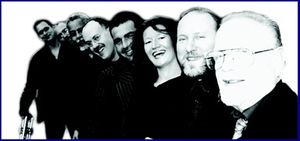 I hung out at Waters blues jam sessions more or less for the next five years to come, going back and forth between Sweden and Germany as often as I could. They played and I howled and it schooled me. One morning about 4 o'clock an old man came to our black-red blues dungeon, sat down on the steaming hot radiator and started playing the blues, and it was the real deal! I suppose there were other musicians there too at the time but it felt like it was only me and him. Stoned and drunk he introduced himself as John C. Marshall from England. He became my musical mentor and has meant more to my understanding of music than any music professor or singing teacher ever has managed to do. For I long time I didn't believe all his stories about having played with Ray Charles, Rosa King or Aretha Franklin until one day he sent me a YouTube clip from the 70's with himself as a front guitarist in the Ray Charles band - then I started to believe and still do.
I hung out at Waters blues jam sessions more or less for the next five years to come, going back and forth between Sweden and Germany as often as I could. They played and I howled and it schooled me. One morning about 4 o'clock an old man came to our black-red blues dungeon, sat down on the steaming hot radiator and started playing the blues, and it was the real deal! I suppose there were other musicians there too at the time but it felt like it was only me and him. Stoned and drunk he introduced himself as John C. Marshall from England. He became my musical mentor and has meant more to my understanding of music than any music professor or singing teacher ever has managed to do. For I long time I didn't believe all his stories about having played with Ray Charles, Rosa King or Aretha Franklin until one day he sent me a YouTube clip from the 70's with himself as a front guitarist in the Ray Charles band - then I started to believe and still do.
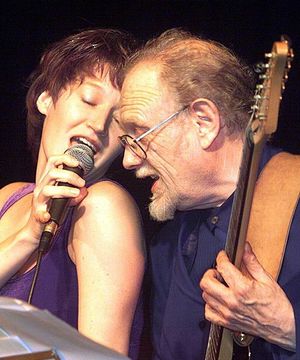 I started singing in his eight-piece rhythm & blues line-up the 'John C. Marshall Band'. In 1999 I finally quit my well-paid engineering job in Sweden, turned in my shining red BMW company vehicle and moved into a tiny student community in Cologne, Germany. Since I still had some attachments left in my old job, John and I ended up making an album for them called 'Blues Business' which featured an original song called 'The Fieldbus Man Blues' - a piece about an electronic programming protocol used in so called 'fieldbuses' in the automation industry. Quite weird, really, to be singing my heart out with all the stereotype blues euphemisms in a song about robotics...but the business world liked it and the tune became quite famous in the world of robot automation as it was used repeatedly in advertising videos all around the world.
I started singing in his eight-piece rhythm & blues line-up the 'John C. Marshall Band'. In 1999 I finally quit my well-paid engineering job in Sweden, turned in my shining red BMW company vehicle and moved into a tiny student community in Cologne, Germany. Since I still had some attachments left in my old job, John and I ended up making an album for them called 'Blues Business' which featured an original song called 'The Fieldbus Man Blues' - a piece about an electronic programming protocol used in so called 'fieldbuses' in the automation industry. Quite weird, really, to be singing my heart out with all the stereotype blues euphemisms in a song about robotics...but the business world liked it and the tune became quite famous in the world of robot automation as it was used repeatedly in advertising videos all around the world.
Next I met my future husband who introduced me to his songs, his Tapas and his beautiful brown eyes and loyal spirit. He inspired me to marry him and to write new material and so we started the band 'Breakfast' on account of our tune 'Breakfast on the roof'. John C. Marshall was game and wrote the horn arrangements, Xaver Fischer played some real hot keys and the rest of the band were made up of the hot blues guys in Johns band. Jens and I then learned the hard way how incredibly difficult it is to pay an eight piece band for every petty little gig and so we ended up reducing ourselves to a mere trio with Jens on acoustic guitar, Max Schaaf on the doublebass and me on vocals and shakers. John played with us whenever he could but often got busy elsewhere.
I guess the highlight of our trio years in Cologne was the 'Cologne Night of Music' festival - a band night with 142 acts all over the city at once for the audience to choose from (none of them getting paid cause the arranger went bankrupt that night!). I remember us giving it all we had with our only grunge piece 'Running and Crying' and the crowd went completely wild and stayed for the next song, and the next. We kept asking them: "Don't you wanna see some other bands too?" and the answer was "Noooooooooo! We want yooou!". Looking back I can honestly say that we weren't that good musically, but there must have been something captivating about us or else they wouldn't have stayed. A lot of bands have that special something that excuses any bloopers, off key singing or questionable timing. Thank God for all the people who don't look for perfection in music, otherwise nobody would stand a chance lest they were perfect already.
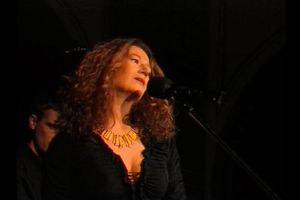 For a long time I kept another blues band "on the side" called the 'Halmstad Connection' because I used to live in Halmstad at the time. What started as a love story between the blues guitarist and me ended with three band members in a tight circle smoking like chimneys and me 50 meters away to avoid both them and the smoke. We managed to record the EP 'Welcome to the blues alley' but didn't make it as a group and so I quit the project in order to concentrate on my work with John and my beautiful and talented husband. Not only because of the smoke though, our differences were just too big and I also felt like moving on from blues to something else.
For a long time I kept another blues band "on the side" called the 'Halmstad Connection' because I used to live in Halmstad at the time. What started as a love story between the blues guitarist and me ended with three band members in a tight circle smoking like chimneys and me 50 meters away to avoid both them and the smoke. We managed to record the EP 'Welcome to the blues alley' but didn't make it as a group and so I quit the project in order to concentrate on my work with John and my beautiful and talented husband. Not only because of the smoke though, our differences were just too big and I also felt like moving on from blues to something else.
After Jens and I moved out of the big city to the country we were contacted by a local bass player named Wilhelm Geschwind who, as it happened, was a phenomenal instrumentalist who'd just returned from a two year tour with the Kelly Family. He broke down our big band arrangements on the 'breakfast on the roof' album into transparent, melodious and really thought-through arrangements for Jens acoustic guitar and his own specially made piccolo double bass, an instrument that looks like and is held like a cello but plays like a double bass. Because he then had both his feet free he ended up using them to tap a stomp box and a home made snare box, turning himself into "two musicians for one"; the ultimate drum + bass player. Willi Geschwind brought us to a new level of musicianship and often drove us mad requesting another rehearsal, and another one. But it paid off in the end, as practicing always does.
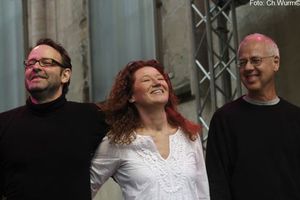 New songs were composed and recorded in three consecutive EP:s with 5 songs each called the Triptychon Series. They three EP:s were later put into one longplay album called the 'Songbook'. I often felt that the slim concept of our small trio was too difficult for the radio world - which was probably true - but the audience loved it! There's a nakedness in musical transparency that hits the listener between the eyes and I guess my voice was given all the space it needed by the sensitive input of Jens guitar and Willis melodic bass. We had quite a lot of positive reviews during those years and a lot of fun too.
New songs were composed and recorded in three consecutive EP:s with 5 songs each called the Triptychon Series. They three EP:s were later put into one longplay album called the 'Songbook'. I often felt that the slim concept of our small trio was too difficult for the radio world - which was probably true - but the audience loved it! There's a nakedness in musical transparency that hits the listener between the eyes and I guess my voice was given all the space it needed by the sensitive input of Jens guitar and Willis melodic bass. We had quite a lot of positive reviews during those years and a lot of fun too.
Musicians are by definition poor so out of great need we worked out a concept for earning money based on my swedishness. IKEA became our main customer for our new 'Swedish Lounge' program for dinner events and soon other companies joined in. We had lots of fun working out new arrangements for popular ABBA-songs but also playing the old traditional folk songs in jazzy versions. Earning money with gala gigs took a lot of time which stole valuable hours from the creative work with our own songs. It's always fun to play music, regardless of the audience, but a listening audience IS better than one that couldn't care less or only a little. Even if the latter pays your rents. Remember our best gig in Cologne - the one we didn't even get paid for 'cause the guy went bankrupt?
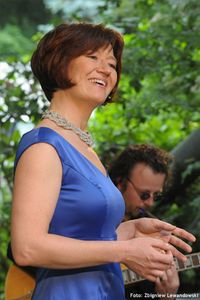 In May 2011 Jens came up with the idea to record all my favorite swedish folk songs with a pianist from Aachen, Stefan Michalke, whose work inspired us right from the first four bars of his first album 'Trotz Regen'. Musicians in his vicinity were chosen, Stefan arranged the songs, two days were spent rehearsing and then we recorded the album...in two days. Never before has a musical process been so easy, effortless and free from strain as the production of 'My Swedish Songbook'. Thanks to Stefan - he did all the work - but also because of the musicians attitude towards the music. The songs were treated with respect, creativity and utter sensitivity in order not to lose the original simplicity of these beautiful folk tunes. These songs have survived at least 50 years of pretentious "jazzifications" so why turn them into something they're not? The result of the recordings came out in 2012 as "My Swedish Songbook" and was way over my wildest expectations.
In May 2011 Jens came up with the idea to record all my favorite swedish folk songs with a pianist from Aachen, Stefan Michalke, whose work inspired us right from the first four bars of his first album 'Trotz Regen'. Musicians in his vicinity were chosen, Stefan arranged the songs, two days were spent rehearsing and then we recorded the album...in two days. Never before has a musical process been so easy, effortless and free from strain as the production of 'My Swedish Songbook'. Thanks to Stefan - he did all the work - but also because of the musicians attitude towards the music. The songs were treated with respect, creativity and utter sensitivity in order not to lose the original simplicity of these beautiful folk tunes. These songs have survived at least 50 years of pretentious "jazzifications" so why turn them into something they're not? The result of the recordings came out in 2012 as "My Swedish Songbook" and was way over my wildest expectations.
Jens and I desperately wanted to take up our own music again and decided to rearrange the band to a quartet. This time we found a cello player with a studio, Shakya Matthias Grahe. Stefan Michalke dusted off his old Fender Rhodes and together with Jens's acoustic guitar we created a whole new band sound. We decided to record the album "FOUR" (2014) in our house in the woods and ended up dressing a whole room with curtains, mattresses and carpets to make the sound right. We had a lot of time to try out new ideas and we used it too - not only to records but to eat and drink for a couple of weekends. After nine months (!) the baby came - the name "FOUR" being the natural sequel to the Triptychon trilogy. We'd been performing unrecorded songs live for years and it felt good to finally put them all on a record.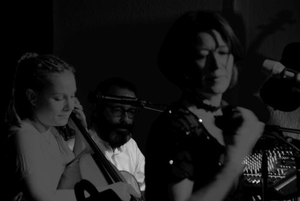 Just one year later our cellist uprooted himself to go live in Switzerland. Needing a new cellist my husband went out to hunt for a female cellist player, preferrably blonde (!) and found Johanna Stein. At that time I'd decided to start a concert series in my home region, I called it "fridhill & friends" due to the concept of inviting artist friends to play a double concert with me and the quartet. Because we played at every concert we decided to present our audience with a couple of new songs every time, so as not to bore anyone, least of all ourselves. I don't think anyone who's never written a song knows how much effort is needed to turn an fuzzy idea into a good, playable song that people actually like. We spent days and nights writing and re-writing lyrics, chord progressions, solo parts, background vocals and counterpoint melodies in time for the next "fridhill & friends" concert and then we would try it out live - often together with the guest artist - only to find out that the audience actually did like it! With our new singing cellist Johanna we suddenly also had a soprano voice on top for the first time and the sound of the three voices together was awesome!
Just one year later our cellist uprooted himself to go live in Switzerland. Needing a new cellist my husband went out to hunt for a female cellist player, preferrably blonde (!) and found Johanna Stein. At that time I'd decided to start a concert series in my home region, I called it "fridhill & friends" due to the concept of inviting artist friends to play a double concert with me and the quartet. Because we played at every concert we decided to present our audience with a couple of new songs every time, so as not to bore anyone, least of all ourselves. I don't think anyone who's never written a song knows how much effort is needed to turn an fuzzy idea into a good, playable song that people actually like. We spent days and nights writing and re-writing lyrics, chord progressions, solo parts, background vocals and counterpoint melodies in time for the next "fridhill & friends" concert and then we would try it out live - often together with the guest artist - only to find out that the audience actually did like it! With our new singing cellist Johanna we suddenly also had a soprano voice on top for the first time and the sound of the three voices together was awesome! Adam Rafferty was invited to the "fridhill & friends" concert in November 2015. He'd become a really good friend over the years so we decided to ask him if he'd want to record a new album with us. One year later we recorded the album "every morning is a new song in the Grammy rewarded Hansahaus Studios in Bonn, Germany. Working together with Adam was like working with John C. Marshall again, the same intense relationship with Music, the same spirit and the same understanding of how things work. The album was released in March 2017.
Adam Rafferty was invited to the "fridhill & friends" concert in November 2015. He'd become a really good friend over the years so we decided to ask him if he'd want to record a new album with us. One year later we recorded the album "every morning is a new song in the Grammy rewarded Hansahaus Studios in Bonn, Germany. Working together with Adam was like working with John C. Marshall again, the same intense relationship with Music, the same spirit and the same understanding of how things work. The album was released in March 2017.